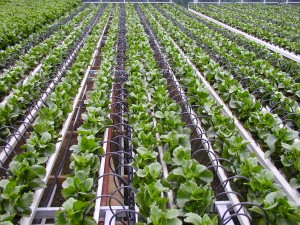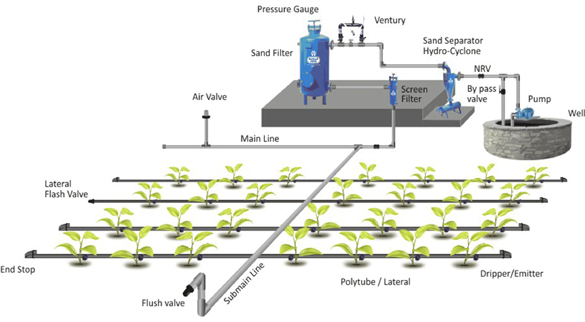Drip Irrigation Systems
Drip irrigation is a form of irrigation that saves water and makes use of manure / fertilizer efficiently by allowing water to draw slowly to the roots of plants / trees, either onto the soil surface or directly onto the root area of plant. The drip irrigation works through a network of valves, pipes, tubing, and emitters. It is done through narrow tubes that deliver water directly to the base of the plant / tree. Drip irrigation system may also use devices called “micro-spray heads”. This device sprays water in a small area of field instead of dripping the water from emitters. Generally, this type of spray heads is used on tree and vine crops with wider root zones.
In case of little w
Main Components involved in Plantations International Drip Irrigation: The following components are used as part of drip irrigation system.
- Pump
- Filtration systems like water filter, sand filter (separator), Fertigation systems (mixing liquid fertilizer with the irrigation water is called “Fertigation”).
- Pressure Controller (Like Pressure Control valve/regulator).
- Back water flow prevention unit.
- Large Pipe and Pipe fittings (Main line Pipes).
- Hydraulic control valves and safety valves.
- Smaller diameter poly-tube which is referred to as “laterals”.
- Poly fittings and accessories to make drip connections.
- Emitters or drippers, micro spray head, in-line dripper or in-line drip tube.
Advantages of Drip Irrigation: The following are the advantages of drip irrigation system.
- Useful in areas where water availability is a major problem.
- Increase in yield and early maturity of crop can be expected.
- Reduces Fertilizer/Nutrient loss due to localized application.
- Makes use of water in highly efficient way.
- Drip irrigation makes intercultural operations easy.
- Water distribution is done uniformly and directly to plant root zone.
- Controls weed growth and soil erosion.
- Land/fields with irregular shapes can utilize drip system very effectively.
- Recycled of waste water can be used without any issue.
- Can save the labour cost when compared to other irrigation methods.
- Reduces the risk of plant and soil borne diseases.
- It can be operated at lower pressure which may reduce energy consumption cost.
- There is no need of levelling the land to be cultivated.
- Because of uniform distribution of water, the plant root zone can be maintained with constant moisture capacity.
- Fertigation (Pumping the fertilizer along with irrigated water through drip system) can be done with minimal waste of fertilizers/micro-nutrients.
- Water output variation can be controlled very easily by operating valves and drippers.
- Due to drip system, soil type plays minimal role in frequency of irrigation.
- Ultimately, drip system saves time and money.
Drip Irrigation Vs Sprinkler Irrigation: Drip irrigation is more beneficial when compared to drip irrigation. The following are the main disadvantages of sprinkler system.
- Sprinkler system results in uneven water application from wind and extreme temperatures.
- There may be water loss from evaporation during irrigation through sprinklers.
- Sprinkler system causes wetting of foliage (collection of plant leaves). This leads to increased risk of disease and fungi growth.
- Improperly maintained sprinkler spray angles near buildings and walkways can damage fixtures.
Cost of Drip irrigation for Farmers
Generally, drip Irrigation provides the facility to irrigate the plants at the root zone through emitters fitted on a network of pipes. The emitting devices could be drippers, micro jets, misters, fan jets, micro sprinklers, mini sprinklers, micro sprayers, foggers and emitting pipes, which are designed to discharge water at prescribed rates. Basically, the use of emitters depends on specific requirements that may vary for each crop. Generally, the factors that decide the choice of the emitting system are; water requirement, age of plant, spacing, soil type, water quality. Sometimes micro-tubes are also used as an emitter, though it is inefficient. All types of surface and subsurface irrigation systems are covered under micro irrigation. An indicative list of system components required for installing a drip irrigation system in areas ranging from 0.4 ha to 5 hectares.
Subsidies on Plantations International Drip Irrigation Systems
The following subsidy information is applicable only for Indian farmers/growers. However, you can contact your local horticulture/agriculture departments for current subsidy information on agriculture drip system.
Centrally Sponsored Schemes and State government schemes are available for drip system subsidy in India. This subsidy varies from state to state and extent of the land owned by farmer.
- Farmers with holding up to 2.5 acres of dry land or 1.5 acres of wet land are defined as Marginal Farmers and are eligible up to 90% of subsidy. However, it varies from state to state, contact your local horticulture/agriculture department or your local Plantations International representative for more information.
- Farmers with holding up to 5 acres of dry land or up to 2.5acres of wet land are defined as Small Farmers and are eligible up to 90% of subsidy. However, it varies from state to state; contact your local horticulture/agriculture department or your local Plantations International representative for more information.
- Farmers with land holding above 5 acres of dry land or above 2.5 acres of wet land are defined as Other Farmers and are eligible up to 60 to 80% subsidy. However, it varies from state to state; contact your local horticulture/agriculture department or your local Plantations International representative for more information.
Farmer Subsidy Eligibility Requirements: The following criteria should explain about Farmer’s eligibility.
- 16% of the total financial target shall be covered by schedule caste farmers.
- 55% of the total financial target shall be covered by schedule Tribes farmers.
- Not less than 25% of total financial target shall be covered by BC farmers.
- Not less than 50% of the total financial target shall be covered by SF/MF farmers.
- Not exceeding 10% of financial target shall be covered by other farmers (more than 5 acres land holding).
- Generally, preference is given to Small and Marginal Farmers, SC/ST/BC/and Women farmers.
To find out more about the Plantations International drip irrigation systems and to receive a free initial consultation, please call us today on +852 5808 3775 or Click Here to contact your nearest Plantations International representative.

